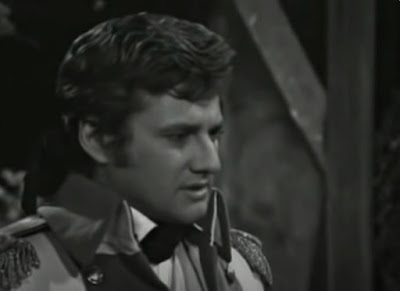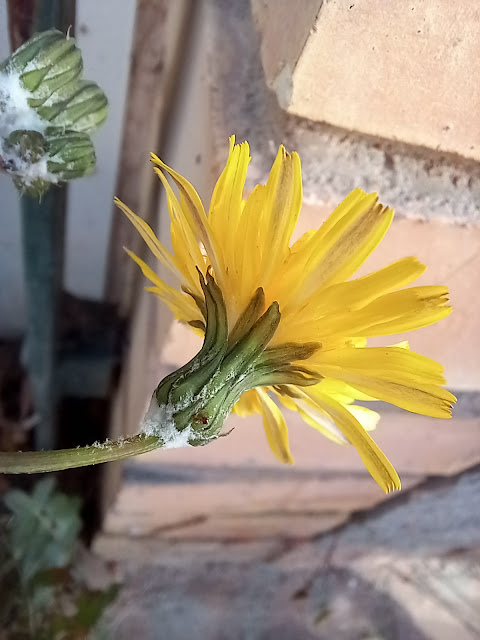 |
| Don Diego (Pablo Sanz) |
[Images clipped from this 1970 Radiotelevisión Española presentation of El sí de las niñas: https://www.youtube.com/watch?v=zCaebQoFFpc . ]
La escena es en una posada de Alcalá de Henares.
The scene is a guest-house in Alcalá de Henares.
El teatro representa una sala de paso con cuatro puertas de habitaciones para huéspedes, numeradas todas. Una más grande en el foro, con escalera que conduce al piso bajo de la casa. Ventana de antepecho a un lado. Una mesa en medio, con banco, sillas, etc.
The stage represents a public room with four doors to guest bedrooms, all numbered. A larger doorway leads to the hallway, with a staircase descending to the ground floor. A chest-high window to one side. A table in the middle, with a bench, chairs, etc.
La acción empieza a las siete de la tarde y acaba a las cinco de la mañana siguiente.
The action starts at seven in the evening and ends at five the following morning.
Acto I, Escena I
Sale DON DIEGO de su cuarto, SIMÓN, que está sentado en una silla, se levanta.
DON DIEGO comes out of his room and SIMÓN, who is sitting in a chair, gets up.
DON DIEGO.- ¿No han venido todavía?
So they still aren't back?
SIMÓN.- No, señor.
No, sir.
DON DIEGO.- Despacio lo han tomado, por cierto.
They're taking a damned long time.
SIMÓN.- Como su tía la quiere tanto, según parece, y no la ha visto desde que la llevaron a Guadalajara...
Since her aunt loves her so much, it seems, and hasn't seen her since they took her to Guadalajara ...
DON DIEGO.- Sí. Yo no digo que no la viese; pero con media hora de visita y cuatro lágrimas estaba concluido.
Yes. I'm not saying she shouldn't see her, but a visit of half an hour, four tears and it's over.
SIMÓN.- Ello también ha sido extraña determinación la de estarse usted dos días enteros sin salir de la posada. Cansa el leer, cansa el dormir... Y, sobre todo, cansa la mugre del cuarto, las sillas desvencijadas, las estampas del hijo pródigo, el ruido de campanillas y cascabeles, y la conversación ronca de carromateros y patanes, que no permiten un instante de quietud.
Strange decision of yours, to go two whole days without setting foot outside the guest-house. Reading gets boring, sleeping gets boring... and what's most boring of all is the dirty room, the rickety chairs, the prints of the Prodigal Son, the sound of church bells and service bells, the shouted conversations of wagoners and peasants so you never get a minute's peace.
DON DIEGO.- Ha sido conveniente el hacerlo así. Aquí me conocen todos: el Corregidor, el señor Abad, el Visitador, el Rector de Málaga... ¡Qué sé yo! Todos. Y ha sido preciso estarme quieto y no exponerme a que me hallasen por ahí.
It suited me to do it this way. Everyone knows me round here: the judge, the abbot, the auditor, the rector of Málaga, and God knows who else... Everyone. And that's just why I chose to stay quietly here and not to reveal myself to whoever might run into me.
SIMÓN.- Yo no alcanzo la causa de tanto retiro. Pues ¿hay más en esto que haber acompañado usted a Doña Irene hasta Guadalajara para sacar del convento a la niña y volvernos con ellas a Madrid?
I don't get why you're keeping such a low profile. Is there something more to this than you escorting Doña Irene to Guadalajara to pick up her little girl from the convent, then going back with them to Madrid?
DON DIEGO.- Sí, hombre; algo más hay de lo que has visto.
Yes, my lad; something more than what you have seen.
SIMÓN.- Adelante.
Go on.
DON DIEGO.- Algo, algo... Ello tú al cabo lo has de saber, y no puede tardarse mucho... Mira, Simón, por Dios te encargo que no lo digas... Tú eres hombre de bien, y me has servido muchos años con fidelidad... Ya ves que hemos sacado a esa niña del convento y nos la llevamos a Madrid.
Something, something... You'll have to know about it eventually, and it can't be delayed much longer... Look here, Simón, for God's sake don't go spreading this around... You're a good man, and you've served me faithfully for many years ... so you see we've collected this child from the convent and we are taking her to Madrid.
SIMÓN.- Sí, señor.
Yes, sir.
DON DIEGO.- Pues bien... Pero te vuelvo a encargar que a nadie lo descubras.
Well, then ... But I repeat, you absolutely must not tell this to anyone.
SIMÓN.- Bien está, señor. Jamás he gustado de chismes.
It's all right, sir. I've never been fond of gossip.
DON DIEGO.- Ya lo sé. Por eso quiero fiarme de ti. Yo, la verdad, nunca había visto a la tal Doña Paquita. Pero, mediante la amistad con su madre, he tenido frecuentes noticias de ella; he leído muchas de las cartas que escribía; he visto algunas de su tía la monja, con quien ha vivido en Guadalajara; en suma, he tenido cuantos informes pudiera desear acerca de sus inclinaciones y su conducta. Ya he logrado verla; he procurado observarla en estos pocos días y, a decir verdad, cuantos elogios hicieron de ella me parecen escasos.
I know that. That's why I want to trust you. I, this is the truth, have never seen Doña Paquita before. But, through my friendship with her mother, I've often heard about her; I've read many of the letters she wrote; I've seen some more from her aunt the nun, who she's been living with in Guadalajara; in short, I've had all the information I could ask for, concerning her inclinations and her conduct. I've managed to see her, I've taken the opportunity to observe her these past few days, and to be frank, all the eulogies they make about her seem to me to fall far short.
SIMÓN.- Sí, por cierto... Es muy linda y...
Yes indeed... She's very pretty and....
DON DIEGO.- Es muy linda, muy graciosa, muy humilde... Y, sobre todo, ¡aquel candor, aquella inocencia! Vamos, es de lo que no se encuentra por ahí... Y talento... Sí señor, mucho talento... Conque, para acabar de informarte, lo que yo he pensado es...
She's very pretty, very gracious, very modest ... And above all, what candour, what innocence! Come on, that's something you just don't find these days... And talented ... Yessir, very talented... And so, to come to the point, what I have been thinking is...
SIMÓN.- No hay que decírmelo.
You don't need to tell me.
DON DIEGO.- ¿No? ¿Por qué?
No? Why not?
SIMÓN.- Porque ya lo adivino. Y me parece excelente idea.
Because I've already worked it out. And it seems to me an excellent idea.
DON DIEGO.- ¿Qué dices?
What are you saying?
SIMÓN.- Excelente.
Excellent.
DON DIEGO.- ¿Conque al instante has conocido?...
And so you knew instantly? ...
SIMÓN.- ¿Pues no es claro?... ¡Vaya!... Dígole a usted que me parece muy buena boda. Buena, buena.
Well, isn't it obvious?... Wow! ... I'm telling you it seems to me a great match. Great, great.
 |
| Simón, Don Diego's servant (Alfonso Gallardo) |
*
I've been reading Leandro Fernández de Moratín's* most admired comedy El sí de las niñas, published in 1806 (written a few years earlier).
Complete text of El sí de las niñas in Spanish:
https://www.cervantesvirtual.com/obra-visor/el-si-de-las-ninas--0/html/ff188e30-82b1-11df-acc7-002185ce6064_2.html
(This is the original version of the text. The book I've been reading is based on Moratín's final revision: which cuts, e.g., the bit about the Corregidor, the Rector de Málaga, etc.)
*
As they go on talking, it becomes apparent that they're at cross purposes. Simón assumes that Don Diego intends the sixteen-year-old Doña Paquita for his nephew (a much more suitable match in terms of age). Don Diego, who is 59, has to spell out that he is actually intending to marry the girl himself. Embarassment all round.
At this stage you might anticipate a story where a lecherous old fool gets his deserved comeuppance, like January in the Merchant's Tale. But it doesn't work like that here. Don Diego isn't much of a lecher and he isn't even, except in this opening scene, much of a fool. As the play proceeds he becomes increasingly dissatisfied with the bland assurances of the loquacious mother and the almost equally maddening compliance of a daughter who seems to be just going through the motions.
(The title means literally "The Yes of the girls" and is usually translated as something like "The Maiden's Consent".)
 |
| Doña Irene, the mother (Carmen Bernardos) |
He begins to see that there's something radically amiss with an educational system that trains girls to comply absolutely with their elders' wishes and hence to conceal all their real feelings. When he discovers that the supposedly closeted Doña Paquita is in fact in love with the aforementioned nephew, he generously stands aside, to the happiness of everyone (even Doña Irene, once she's got over wanting to scratch her daughter's eyes out).
 |
| Doña Paquita [= Francisca], the daughter (Isabel María Pérez) |
*
Antonio Calvo Maturano's lively 2012 essay introduces El sí de las niñas to readers of Jane Austen's Sense and Sensibility, usefully bringing out the differences between the literature of absolutist Spain and democratic England, the different questions being asked; the progressivism isn't all on one side, both works treading a path between conservatism and reformism.
https://jasna.org/persuasions/on-line/vol32no2/calvo.html
An interesting point he makes is that Moratín's attack on unequal marriages was in line with the thinking of the absolutist regime, alarmed by an upper-class culture in which marital infidelity was becoming the norm. They thought it led to social instability (as well as a lot of young, unmaintained widows).
 |
| Rita, the ladies' maid (María Silva) |
*
A chat with Doña Paquita (in Spanish), along with some fabulous pictures, by María Ángeles Merino:
https://aranitacampena.blogspot.com/2014/05/el-si-de-las-ninas-y-enamorado-mas-que.html
 |
| Don Carlos, the nephew (Carlos Larrañaga) |
El sí de las niñas has been translated into English a few times over the years. I couldn't find any of the older translations online, but what I did find was a 2007 version by Christopher O. Kidder (for his Masters degree) that's a whole lot of fun:
It's part way between a translation and an adaptation (the sort of halfway house that was the norm in most earlier eras of drama, until copyright started to get in the way): overall, it gives a pretty faithful idea of the original play, but it slims down some of the more historical detail, turns Doña Irene's thrush into a parrot, and sprinkles the play with a bunch of new wisecracks and gags. (The idea of attaching Don Carlos' love-letter to a brick is absolutely inspired.)
 |
| Calamocha, Don Carlos' servant (Tomás Zorí) |
Moratín was a firm believer in the dramatic unities, the gospel promulgated in Spain by Luzán. El sí de las niñas is set in a single location over a period of less than twelve hours, and it has just seven roles, all of them good opportunities for the actors to show their chops. (After all, it's not enough for a play to just please the public. If it pleases the actors too, it will get performed.)
You can see the good and not so good in this. In drama things happen and characters change as a result, but there's something artificial about character changes that occur within such a constrained timescale. It highlights the performance aspect of drama rather than the mimetic aspect; it unfolds like an intricate dance. But when we see Hamlet change, or Horatio, we believe it; we recognise the characteristic flow of a personality through time. Because in Shakespeare's double-time dramas, it isn't possible to say exactly how much time passes between Act I and Act V.
And lot gets excluded from such unity. Only afterwards do we wonder about the past and the future; for instance, how such an eligible gent as Don Diego happened to be still single at 59, or how a professional soldier like Don Carlos is going to square career with marriage.
But at the same time, there's a pleasure to such a well-engineered mechanism. It feels like it can never go stale, like every time we set the play going we'll want to see it through to the end, the dramatic impetus never flagging, each new scene accompanied by fresh anticipation, and our applause at the final curtain just as assured as all the rest.
*
* That is his short name. His full name was Don Leandro Antonio Eulogio Melitón Fernández de Moratín y Cabo. He was born in Madrid in 1760 and died in Paris in 1828.
Labels: Leandro Fernández de Moratín, Specimens of the literature of Spain
































